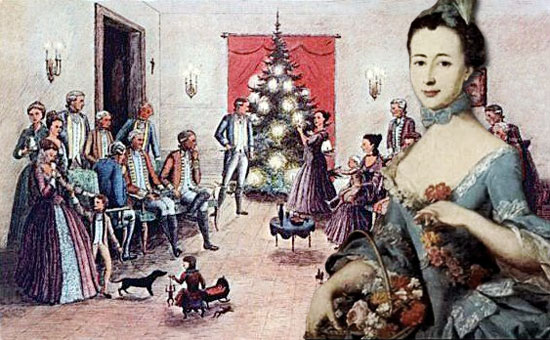Canada's First Christmas Tree — A Tale of War & Bloodshed
/It's Christmas Eve, 1781. And in the town of Sorel, Québec, the Riedesels are throwing a party. The family has a lot to celebrate: this is the first Christmas in four years they've been able to enjoy the holiday in freedom. They've been through a harrowing ordeal of horror and bloodshed. But now, it's finally over.
The Baroness Frederika Riedesel is determined to throw a particularly remarkable bash to mark the joyous occasion. And to help make it memorable, she's brought a new tradition to Canada — one that more than two hundred years later will still be practiced by millions of families across the country every December. The baroness has put up a Christmas tree.
The Riedesels were German. Frederika was the daughter of a Prussian minister; her husband Frederich was an officer in the army. They met after he was wounded while fighting the French during the Seven Years' War — the young Frederika, just sixteen years old, helped nurse him back to health. They were married later that very same year.
At first, they led a quiet life together in Germany, but the peace wouldn't last. Soon, another war broke out. Three years after Frederika and Frederich got married, the American Revolution began. Many German states came to the aid of the British — and the Riedesels found themselves far on the other side of the Atlantic, living in Québec while Frederich helped to defend the Canadian colonies against the American rebels.
In 1777, the British launched a new campaign against the Americans. They marched south from Canada into New York State in an attempt to seize Albany. They weren't alone: Joseph Brant led a force of First Nations allies, while Riedesel commanded thousands of German troops.
His family came with him. Frederika and their daughters accompanied the army, travelling in a carriage as the soldiers marched south. The baroness kept a detailed diary that provides an invaluable record of the campaign — and it's filled with horrors.
She was an eye witness as the British and their allies clashed with the rebels. She saw men with limbs blown off by cannonballs; watched as they took their last breaths. She sheltered beneath a rain of cannon fire; barely escaped a burning building. Far from being a passive witness, Frederika played an active role in the campaign: she tended to wounded soldiers, organized their care, and even took the British general to task for doing a poor job of feeding his hungry troops. One German solider called her an "angel of comfort" who "restored order in the chaos."
But the Saratoga Campaign was doomed to failure. Four months after leaving Québec, the British army surrendered to the Americans.
The Riedesels were now American prisoners. They spent two years in captivity, held with the rest of the army in Virginia, and then another two years on parole in New York City, where they suffered through a smallpox epidemic that nearly took Frederich's life. It wasn't until the summer of 1781 that they were finally released in exchange for an American general who'd been captured by the British during the Battle of Trois-Rivières.
Free at last, the Riedesels returned to Canada. Frederich was put in charge of Fort Sorel — a short trip from Montreal, at the spot where the Richelieu River meets the St. Lawrence. A few days before Christmas, the family moved into a brand new stone house that had just been built on the banks of the river. It's still there today, open to the public as a tourist attraction: the Maison des governeurs.
Frederika was now 35 years old. In the early years of her marriage to Frederich, a friend described her as looking like "an unmarried girl who is just being brought to boarding school, instead of ... a married woman." But now, she'd grown into her role as a baroness: with striking red hair, "full in figure and possessing no small share of beauty."
The party she threw that Christmas Eve would prove be one of the most remarkable in Canadian history. It was a deeply symbolic event. British and German officers came together in the Riedesels' new home in a celebratory union of their two cultures.
For dessert, the baroness served a plum pudding — an old English Christmas tradition that survives to this day.
But even more remarkable was the German tradition she organized for the party. As the revellers enjoyed their evening, a fir tree stood in the corner. Its branches were decorated with candy and fruit, and illuminated by flickering candles. In the morning, the children would find their gifts nestled under the tree, just like many children across Canada still do today.
In Germany, Christmas trees had been a part of Christmas celebrations since at least the 1500s. But this was the first time someone had brought that tradition across the ocean. The Riedesels' Christmas tree wasn't just the first Christmas tree ever displayed in Canada — it was the first Christmas tree to appear anywhere on this continent.
The American Revolution wasn't over. It would be another two years before the Treaty of Paris formally ended the hostilities and the Riedesels headed home to Germany. But on Christmas Eve, the British and German defenders of Canada came together in that stone house on the banks of the Richelieu River to rest and to enjoy themselves. And for that one winter evening at least, they could try to forget the horrors of war, with their bellies full of plum pudding and their faces bathed in the warm glow of the first Canadian Christmas tree.
Have you checked out our award-winning series on YouTube? Find over 30 exciting and unique episodes here: https://www.youtube.com/canadiana
Want to read more stories like this? Become a champion of Canadiana on Patreon. Just a little monthly donation helps us to continue our hunt for the most incredible stories in Canadian history — and gets you access to exclusive content and other perks.

